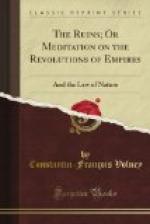That, in his infancy, this restorer of divine and celestial nature would live abased, humble, obscure and indigent.
“And this, because the winter sun is abased below the horizon; and that this first period of his four ages or seasons, is a time of obscurity, scarcity, fasting, and want.
“That, being put to death by the wicked, he had risen gloriously; that he had reascended from hell to heaven, where he would reign forever
“This is a sketch of the life of the sun; who, finishing his career at the winter solstice, when Typhon and the rebel angels gain the dominion, seems to be put to death by them; but who soon after is born again, and rises* into the vault of heaven, where he reigns.
* Resurgere, to rise a second time, cannot signify to return to life, but in a metaphorical sense; but we see continually mistakes of this kind result from the ambiguous meaning of the words made use of in ancient tradition.
“Finally, these traditions went so far as to mention even his astrological and mythological names, and inform us that he was called sometimes Chris, that is to say, preserver,* and from that, ye Indians, you have made your god Chrish-en or Chrish-na; and, ye Greek and Western Christians, your Chris-tos, son of Mary, is the same; sometimes he is called Yes, by the union of three letters, which by their numerical value form the number 608, one of the solar periods.** And this, Europeans, is the name which, with the Latin termination, is become your Yes-us or Jesus, the ancient and cabalistic name attributed to young Bacchus, the clandestine son (nocturnal) of the Virgin Minerva, who, in the history of his whole life, and even of his death, brings to mind the history of the god of the Christians, that is, of the star of day, of which they are each of them the emblems.”




